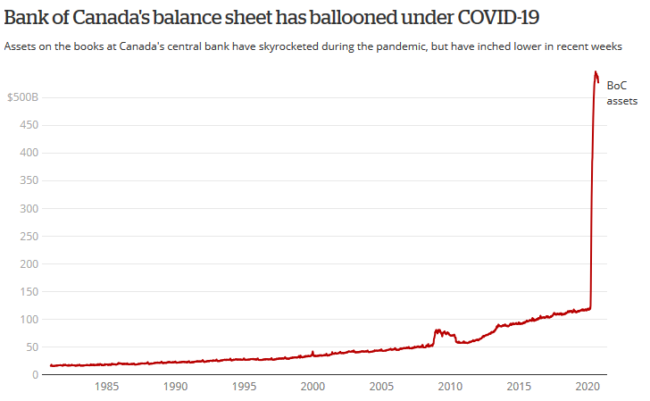The Bank of Canada is winding down three emergency programs it set up to provide support to financial institutions during the early days of the pandem
The Bank of Canada is winding down three emergency programs it set up to provide support to financial institutions during the early days of the pandemic, as demand for all three programs is falling now that things are getting back to normal.
In a news release late Thursday, the central bank said it will close two programs known as the Bankers’ Acceptance Purchase Facility, or BAPF, and the Canada Mortgage Bond Purchase Program, or CMBPP, as of Oct. 26. The bank also said it will reduce the frequency of another program, known as the Term Repo operations, from once a week to every two weeks starting on Oct. 21.
The programs are all slightly different in their focus but serve the same broad function: they were set up in the spring as a way to ensure that financial firms have access to cash to lend out to credit-worthy consumers and businesses that need it.
The mortgage bond program accomplished this by having the central bank buy up billions of dollars worth of insured mortgages from lenders and move them on to its balance sheet, which makes it easier for lenders to go out and lend money to someone else.
The bankers’ acceptances and repo or “repurchase” programs functioned much the same way, each essentially lowering the cost of borrowing for financial firms that participated, so that those companies could then turn around and lend money out to consumers and businesses as cheaply as possible, too.
The central bank said it was willing to take on up to $500 million worth of mortgages a week as of March, and some weeks came close to that threshold. But since August, banks have been using the program much less.
Similarly, the bankers’ acceptances hasn’t been used since April, and the term repo facility was used heavily up until about May, but lightly so ever since.
Economist Benjamin Reitzes with Bank of Montreal says the market reacted by driving up the yields on existing CMBs by a few basis points, something he described as an “overreaction.”
“The announcement comes as a bit of surprise as there was no hint of this coming, and so the knee-jerk reaction can be forgiven,” he said.
“The program hasn’t seen significant use in recent months so the termination makes some sense.[And] the housing market is absolutely on fire, so it’s not as if it needs any more support.”
Scaling back other programs
The moves come about a month after the central bank announced it was scaling back two other emergency programs, one to buy provincial money market securities and another that bought up federal government treasury bills for the same reason — to backstop liquidity.
All of these liquidity programs winding down are a sign that the financial system is getting back to normal, and the bank no longer feels obligated to roll out emergency programs to keep things running.
“Canadian banks are flush with cash right now,” said Ian Pollick, head of fixed income at CIBC.
He said Canadian banks are currently sitting on about $330 billion in cash and cash equivalents — 10 times the level they had before the pandemic — so it’s small wonder there is now limited demand for these emergency programs.
“There has not been any take-up in the Bank of Canada’s term-repo operations for four consecutive weeks now,” Pollick said.
While the moves were an encouraging sign that things may be getting back to normal, the bank made it clear it is ready to reopen the programs if things change.
“The Bank remains committed to providing liquidity as required to support the functioning of the Canadian financial system,” the Bank of Canada said. “Any discontinued facilities can be restarted if necessary.”
Source : www.cbc.ca


